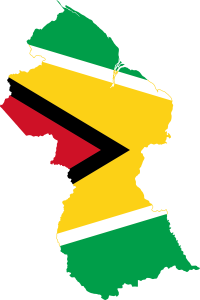Everything You Need To Know For Guyana
Geographical Position And Climate Of Guyana
Guyana is located on the northern coast of South America, bordered by Venezuela to the west, Brazil to the south and southwest, Suriname to the east, and the Atlantic Ocean to the north.
The climate in Guyana is tropical and generally hot and humid, with two main rainy seasons. The first rainy season occurs from May to mid-August, and the second one from mid-November to mid-January. The country’s interior highlands experience slightly cooler temperatures, while the coastal region, where the majority of the population lives, tends to be warmer. Despite the rain, the weather remains relatively consistent throughout the year due to its equatorial position.
Brief History Of Guyana
Guyana’s history is shaped by its indigenous Amerindian tribes, followed by Dutch colonization in the 17th century. The British took control in the late 18th century, and the territory was officially named British Guiana. The colonial era saw the importation of African slaves and, later, indentured laborers from India, creating a diverse cultural landscape. Guyana achieved independence from Britain in 1966 and became a republic in 1970. Post-independence, the country experienced political turmoil and economic challenges but has maintained its rich cultural heritage and is known for its vast, unspoiled rainforests.
Religion Of Guyana
The most practiced religion in the country is Christianity, followed by Hinduism and Islam.
Language Of Guyana
English is the country’s official language.

Guyana is an emerging eco-tourism destination known for its pristine rainforests, rich biodiversity, and vibrant indigenous culture. It offers a unique blend of South American and Caribbean experiences with English as the official language. Visitors can explore the vast expanses of untouched nature, including Kaieteur Falls, one of the world’s highest single-drop waterfalls, and the Iwokrama Rainforest Reserve. Wildlife enthusiasts have opportunities to spot jaguars, giant river otters, and numerous bird species. Cultural tourism includes interactions with local Amerindian communities, while adventure seekers can enjoy activities like river kayaking, hiking, and fishing. Guyana’s commitment to sustainable tourism practices makes it an attractive destination for eco-conscious travelers.
Places You Must Visit In Guyana
Before You Visit Guyana
Travel to Guyana
Travelers can get to Guyana primarily by air, with the main point of entry being Cheddi Jagan International Airport near the capital city, Georgetown. There are direct flights from several major cities in the Caribbean, North America, and South America.
Overland travel to Guyana is possible through border crossings from neighboring Brazil and Suriname, though these routes can be challenging and are less commonly used by tourists. There is no road link from Venezuela due to the dense forest and political tensions.
Once in Guyana, domestic travel is often conducted by small aircraft to reach remote areas, as well as by river boats and 4×4 vehicles for overland journeys, given the country’s limited road infrastructure and vast natural landscapes.
Visas for Guyana
Visa requirements for Guyana vary depending on the traveler’s nationality. Citizens from countries such as the United States, Canada, United Kingdom, Commonwealth countries, and most CARICOM member states do not require a visa for stays of up to 90 days.
Travelers from countries that are not visa-exempt must apply for a visa at a Guyanese embassy or consulate prior to their arrival. The types of visas include tourist, business, student, and transit visas, among others.
It is important for all travelers to check the latest visa requirements with the nearest Guyanese diplomatic mission or their official government website before planning their trip, as visa policies can change. Additionally, visitors should ensure their passport is valid for at least six months beyond the duration of their intended stay in Guyana.
Best time to visit Guyana
The best time to visit Guyana is during the dry seasons, which typically run from mid-August to December and from late January to April. During these periods, the weather is more conducive to travel, with less rainfall making it easier to navigate the country’s terrain and enjoy outdoor activities such as wildlife viewing, hiking, and visiting natural attractions like Kaieteur Falls.
The dry seasons are also ideal for exploring the savannas of the Rupununi and engaging with indigenous communities. However, travelers should be prepared for high humidity and warm temperatures year-round due to Guyana’s tropical climate.
Visiting during local festivals, such as Mashramani in February, can add a cultural dimension to your trip, allowing you to experience Guyana’s vibrant traditions and hospitality.
Important Information
Capital – Georgetown
Territory – 215,000 km2
Currency – Guyanese dollar (GYD)
Time Zone – UTC-4 (AST)
Population – 817,607
Demonym – Guyanese
